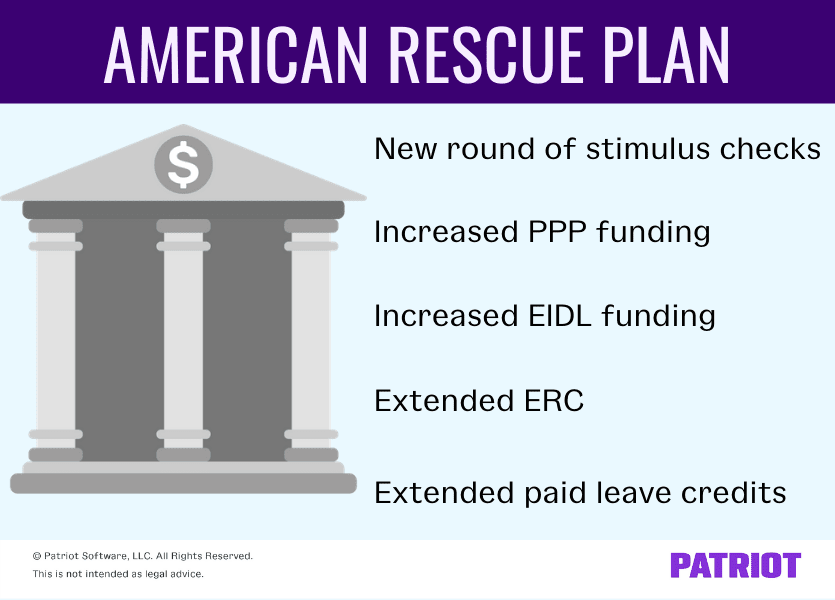The latest COVID package to come out of Washington D.C. (and the first of 2021) has been signed into law. Dubbed the American Rescue Plan, this legislation is jam-packed with relief measures aimed at individuals and businesses.
Read on to learn the basics of what’s in the economic relief package, and get a closer look at the measures aimed at businesses.
What you need to know about the American Rescue Plan
The American Rescue Plan Act of 2021 is a $1.9 trillion bill aimed at offering COVID-19 relief. The House passed it on February 27, 2021 and the Senate on March 6, 2021. Because it originated in the House and the Senate made changes to, it went back to the House and passed on March 10, 2021. President Biden signed it into law on March 11, 2021.
So, what exactly is in the American Rescue Plan Act of 2021? In a word: Lots. Use the table below to learn the major provisions in the COVID relief plan and get a brief overview of what each does.
| What’s in the American Rescue Plan: Major Provisions | What It’s For: The Highlights |
|---|---|
| Unemployment benefits | Extends enhanced unemployment benefits of an additional $300 per week through September 6, 2021 |
| Stimulus checks | Provides $1,400 in direct payments to qualifying individuals |
| State and local aid | Helps states and localities cover expenses relating to COVID-19 hardships |
| Paycheck Protection Program | Increases funding to the PPP by $7.25 billion and expands eligibility for not-for-profits |
| Economic Injury Disaster Loan | Adds $15 billion in funding for EIDL advance payments |
| Employee Retention Credit | Extends employers’ ability to claim the ERC through December 31, 2021 and expands eligibility to new startups |
| Paid leave credits | Extends COVID-19 paid sick and family leave credits through September 30, 2021 and increases covered paid family leave wages to $12,000 |
| Earned Income Tax Credit | Raises the maximum EITC for adults without children to $1,502 |
| Health and nutrition | Increases COVID testing and vaccine distribution; changes COBRA coverage so individuals do not have to pay premiums through September 30, 2021; provides healthcare services to veterans; and increases nutrition program funding for 2021 |
| Child tax credits | Increases the maximum Child Tax Credit to $3,000 per child ($3,600 per child under the age of 6), as well as temporarily increases the Child and Dependent Care Credit |
| Education | Provides funding to K-12 schools |
| Rent, utility, and mortgage assistance | Provides aid to individuals who cannot cover rent, utility, and mortgage expenses |
How will the rescue package help businesses?
As you can see, there’s a lot in the White House stimulus package. As a business owner, here are the main parts you need to know:
- New round of stimulus checks
- Increased PPP funding
- Increased EIDL funding
- Extended ERC
- Extended paid leave tax credits
Take a look at what’s changing for business owners with the new relief plan below.

1. New round of stimulus checks
Another COVID-19 bill, another round of stimulus checks (aka economic impact payments). The new coronavirus relief package works similarly to the ones sent out under the CARES Act and Consolidated Appropriations Act. However, there are a few differences.
This time around, the maximum stimulus check amount is $1,400 per person or $2,800 per married couple. As always, the amount you receive can vary depending on your adjusted gross income (AGI).
Individuals can receive the full $1,400 stimulus check as long as their AGI is less than:
- $75,000 (individuals)
- $112,500 (head of household)
- $150,000 (married)
You can also receive an additional $1,400 for each qualifying dependent you have. Dependents include full-time students younger than 24 and adult dependents.
Like the other round of stimulus payments, you can receive a reduced stimulus check amount if your AGI is between a certain amount (e.g., $75,000 – $80,000 for individuals).
You are not eligible for this round of checks if you AGI is more than:
- $80,000 (individuals)
- $120,000 (head of household)
- $160,000 (married)
Economic impact payments are based on your 2019 or 2020 tax return. If you have not filed your 2020 return yet, the IRS will use your 2019 tax return information.
For more information on the next round of stimulus checks, take a look at our article, “Is a Stimulus Check En Route to You? FAQs About Economic Impact Payments.”
2. Increased PPP funding
Under Biden’s plan for COVID relief, the Paycheck Protection Program (PPP) is receiving $7.25 billion in additional funding.
As a brief recap, the PPP provides forgivable loans to small businesses to help cover up to 24 weeks of qualifying payroll and non-payroll costs.
In order to qualify for loan forgiveness, business owners must use PPP loan funds on eligible expenses, including:
- Payroll costs: 60% of loan proceeds
- Non-payroll costs: 40% of loan proceeds
The Consolidated Appropriations Act signed into law in December 2020 reopened and expanded the PPP through March 31, 2021. Although the American Rescue Plan provides additional funding to the PPP, it did not extend the deadline of March 31. However, President Biden signed the Paycheck Protection Program Extension Act of 2021 on March 31, extending the PPP until May 31, 2021.
Along with providing additional funding, the new COVID relief package allows more not-for-profits to be eligible and apply for the PPP by creating a new category called “additional covered nonprofit entity.” This new category includes 501(c)s other than 501(c)(3), 501(c)(4), 501(c)(6), or 501(c)(19) organizations. Not-for-profits listed in Sec. 501(c) of the Internal Revenue Code can receive initial PPP loans if the:
- Organization does not receive more than 15% of receipts from lobbying activities;
- Lobbying activities do not make up more than 15% of activities;
- Cost of the organization’s lobbying activities did not exceed $1 million during the most recent tax year that ended prior to Feb. 15, 2020; AND
- Organization does not employ more than 300 employees
Additionally, some larger not-for-profit organizations are now eligible for a PPP loan. These include:
- Larger 501(c)(3) organizations and veterans’ organizations that employ no more than 500 employees per physical location
- Larger 501(c)(6) organizations, domestic marketing organizations, and additional covered not-for-profit entities that employ no more than 300 employees per physical location
3. Increased EIDL funding
The new relief plan also provides an additional $15 billion in funding to the Economic Injury Disaster Loan (EIDL) program for advance payments. The EIDL is a coronavirus loan option through the Small Business Administration (SBA). An EIDL is available to small businesses affected by a declared disaster, like the coronavirus pandemic.
The relief package provides funding to businesses in low-income communities that have:
- No more than 300 employees AND
- Suffered an economic loss of more than 30%
- This is determined by how much the business’s gross receipts declined during an eight-week period between March 2, 2020 – December 31, 2020 compared to an eight-week period immediately preceding March 2, 2020
Eligible small businesses can receive up to $10,000 each from the EIDL program.
4. Extended ERC
The Employee Retention Credit (ERC) is another relief measure for businesses established under the CARES Act. The ERC is a fully refundable tax credit that employers who are able to keep employees on payroll can claim.
Back in December 2020, the Consolidated Appropriations Act extended and expanded the Employee Retention Credit through June 30, 2021. Thanks to the American Rescue plan, the credit is now extended through December 31, 2021.
The new COVID-19 legislation also expands eligibility for the credit to:
- New startups that were established after February 15, 2020 with annual gross receipts of up to $1 million
- Credit capped at $50,000 per calendar quarter for startups
- Businesses that experienced a revenue decline of 90% or more (compared to the same calendar quarter of the previous year)
Eligible employers who experience a full or partial shutdown due to COVID-19 or a qualifying decline in their receipts in 2021 may qualify for the Employee Retention Credit.
5. Extended paid leave tax credits
The Families First Coronavirus Response Act (FFCRA) originally established coronavirus paid leave and corresponding tax credits to offset the expenses. Since then, both the Consolidated Appropriations Act and American Rescue Plan have extended the program.
Take a look at COVID-19 paid leave under each piece of coronavirus legislation:
- Families First Coronavirus Response Act: Established mandatory paid sick and family leave, as well as the corresponding tax credit, between April 1, 2020 – December 31, 2020
- Consolidated Appropriations Act: Made paid sick and family leave, as well as the corresponding tax credit, a voluntary option between January 1, 2021 – March 31, 2021
- American Rescue Plan: Creates a “reset” date for counting paid sick leave on March 31, 2021. Allows employers to claim tax credits between April 1, 2021 – September 30, 2021 if they choose to provide COVID-19 paid sick and family leave and increases the wages covered by the paid family leave credit to $12,000 per employee (up from $10,000 / employee)
Here’s a brief overview of the paid leave rules under the American Rescue Plan:
- Paid sick leave (self): Employees can take paid sick leave if they are quarantining or isolating due to COVID-19, receiving a vaccination, or dealing with vaccination complications and receive their regular rate of pay, up to $511 per day for 10 days ($5,110 max)
- Paid sick leave (others): Employees can take paid sick leave to care for someone who is quarantining or isolating due to COVID-19 and receive two-thirds of their regular rate of pay, up to $200 per day for 10 days ($2,000 max)
- Paid family and medical leave: Employees can take paid family leave to care for a child whose school or childcare center has closed and receive two-thirds of their regular rate of pay, up to $200 per day for 60 days ($12,000 max)
Keep in mind that, on July 29, 2021, President Biden further expanded paid leave under the ARP to provide paid sick leave (others) to employees accompanying an individual who is obtaining a vaccine or caring for someone recovering from vaccination.
To stay up-to-date on the latest COVID-19 legislation, rules, and software updates, check out Patriot’s COVID-19 Resources.
This article has been updated from its original publication date of March 11, 2021.
This is not intended as legal advice; for more information, please click here.



